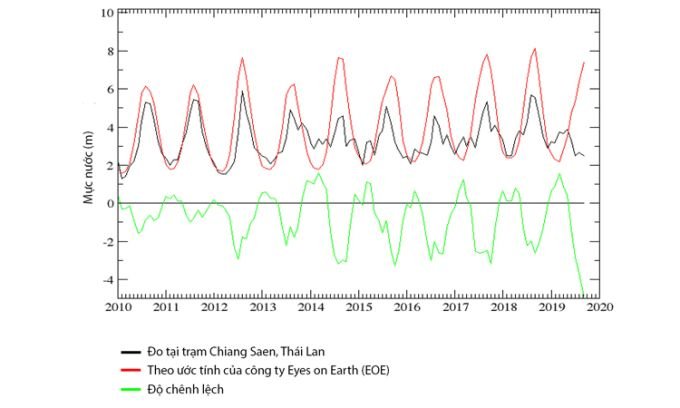
`In 2019, the water level of the Mekong River measured at the Chiang Saen station was much lower than the estimated natural flow,` said Alan Basist, Director of Eyes on the Earth (EOE), co-author of the report
According to Basist, the EOE, funded by the US State Department, used data from satellites to estimate the natural flow of the Mekong River from 1992 to 2019. The EOE compiled the difference in natural flow and measured water flow
The black line is the actual water volume measured at Chiang Saen, the red line is the EOE’s estimated water volume.
Mekong River water level from January 2010 to September 2019.
`From the above data, we speculate that the natural flow of the Mekong River has been completely blocked by hydroelectric dams in China,` Basist said.
In fact, in July 2019, the MRC released a report showing that the Mekong River water was below record low levels.
Basist lists the 11 Chinese hydroelectric dams operated between 1993 and 2018 as Manwan, Dai Chaoshan, Jinghong, Tieuwan, Noozhudu, Miaowei, Huangdang, Daihuaqiao, Gongguoqiao, Lide
According to Basist, China also changed the natural flow of the Mekong River by releasing water to operate hydroelectric dams.
EOE data shows that in 2002, an unusually large amount of Mekong River water flowed downstream.
`The Mekong River water during the 2002 dry season increased and decreased dramatically compared to the natural flow prediction index,` Basist said.

Mekong River water level from January 2001 to December 2009.
After 2012, when the Noa Trac Do dam operated, the natural flow of the Mekong River was significantly adjusted.
In the report Monitoring the Volume of Water Flowing Through the Upper Mekong, Basist and colleagues point out that between 1994 and 2008, Mekong River flow data measured at the Chiang Saen station and flow estimate data
Basist believes that the Mekong’s natural flow is essential to maintaining the vitality of the river and the integrity of the entire basin.

China’s Nuremberg hydroelectric dam on the upper Mekong River.
Explaining further the impact when China changes the natural flow of the Mekong River, Brian Eyler, Southeast Asia Program Director, Stimson Research Center, USA, said that the ecosystem of the Mekong River plays an extremely important role.
Eyler said that for decades, China kept secret information about the operation of hydroelectric dams and the amount of water released downstream, not sharing it with relevant countries.
Mr. Dao Trong Tu, former deputy secretary general of the Vietnam Mekong River Commission, said that besides China – MRC cooperation, there is also the Mekong – Lan Thuong mechanism, focusing on 5 areas, including connectivity and production capacity.
According to Mr. Tu, new data related to the Mekong River, including that of the EOE, will help downstream countries have more tools to monitor the situation and communicate with China.
`Now is the time for China to take responsibility for sharing data with other countries. That is the best step for Beijing to become a constructive partner in the region,` Eyler told VnExpress.
Vietnamese-English








